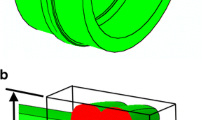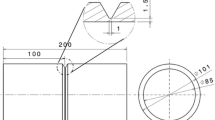Abstract
High-density polyethylene (HDPE) pipes have become the preferred water pipes in nuclear power plants. Since the butt fusion–welded joint of HDPE pipes is a weak link of a piping system, it is essential to study the creep properties of the welded joint. In this study, the creep properties of the welded joint of HDPE pipes were studied using a nanoindentation creep test. The test results showed that the weakest creep resistance was not located in the weld center, but was a little away from the weld center. The power-law creep constitutive model was constructed at different locations of the welded joint based on the test results. In addition, the hardness of the welded joint was tested. The results showed that the hardness of the welded joint could reflect the creep resistance of the welded joint.














Similar content being viewed by others
Abbreviations
- A :
-
Projected contact area
- c :
-
Constant depending upon the geometry of the indenter
- F :
-
Applied load
- H :
-
Hardness
- h :
-
Contact depth
- h pc :
-
Creep displacement
- n :
-
Power-law creep stress exponent
- \(\dot{\varepsilon}\) :
-
Creep strain rate
- σ :
-
Stress
- λ :
-
Power-law creep constant
References
Adel NH (2013) ASME Code development roadmap for HDPE pipe in nuclear service, ASME STP-NU-057. ASME Standards Technology, LLC, New York
Lai HS, Kil SH, Yoon KB (2015) Effects of defect size on failure of butt fusion welded MDPE pipe under tension. J Mech Sci Technol 29(5):1973–1980
Li H, Gao B, Dong J, Fu Y (2016) Welding effect on crack growth behavior and lifetime assessment of PE pipes. Polym Test 52:24–32
Kalyanam S, Krishnaswamy P, Shim DJ, Hioe Y, Focht E (2012) Structural integrity of HDPE piping and joints in nuclear safety-related applications. Proc 20th Int Conf Nucl Eng Asme 2012 Power Conf 4:51–62
Lai HS, Tun NN, Yoon KB, Hee SK (2016) Effects of defects on failure of butt fusion welded polyethylene pipe. Int J Press Vessel Pip 139-140:117–122
Farid VT, Mohammad RA (2017) Using developed creep constitutive model for optimum design of HDPE pipes. Polym Test 63:392–397
Troughton M, Khamsehnezhad A (2016)Short-term and long-term mechanical testing to evaluate the effect of flaws in butt fusion joints in polyethylene pipes. Proceedings of the ASME Pressure Vessels and Piping Conference, Vancouver
Troughton M, Scandurra A (2002) Predicting the long-term integrity of butt fusion joints in polyethylene pipes. 17th International Plastic Fuel Gas Pipe Symposium, San Francisco
Li X, Bhushan B (2002) A review of nanoindentation continuous stiffness measurement technique and its applications. Mater Charact 48(1):11–36
Suwanprateeb J (2004) Rapid examination of annealing conditions for HDPE using indentation microhardness test. Polym Test 23(2):157–161
Oliveira GL, Costa CA, Teixeira SCS, Costa MF (2014) The use of nano-and micro-instrumented indentation tests to evaluate viscoelastic behavior of poly (vinylidene fluoride) (PVDF). Polym Test 34:10–16
Lach R, Hutar P, Vesely P, Nezbedova E, Grellmann W (2013) Assessment with indentation techniques of the local mechanical behavior of joints in polymer parts. Polimery Warsaw 58(11):900–905
Shaheer M, Troughton M, Khamsehnezhad A, Song J (2017) A study of the micro-mechanical properties of butt fusion-welded joints in HDPE pipes using the nanoindentation technique. Weld World 61(4):819–831
Huang CC, Wei MK, Lee S (2011) Transient and steady-state nanoindentation creep of polymeric materials. Int J Plast 27:1093–1102
Gao CH, Liu M (2017)Power-law creep of polycarbonate by Berkovich nanoindentation. Mater Res Express 4:105302
Adewole JK, Al-Mubaiyedh UA, Ul-Hamid A, Al-Juhani AA, Hussein IA (2012) Bulk and surface mechanical properties of clay modified HDPE used in liner applications. Can J Chem Eng 90(4):1066–1078
Sahu SK, Badgayan ND, Samanta S, Sreekanth R (2018) Quasistatic and dynamic nanomechanical properties of HDPE reinforced with 0/1/2 dimensional carbon nanofillers based hybrid nanocomposite using nanoindentation. Mater Chem Phys 203:173–184
Goodall R, Clyne TW (2006) A critical appraisal of the extraction of creep parameters from nanoindentation data obtained at room temperature. Acta Mater 54(20):5489–5499
Lucas BN, Oliver WC (1999) Indentation power-law creep of high-purity indium. Metall Mater Trans A - Physical Metall Mater Sci 30(3):601–610
Mayo MJ, Nix WD (1988) A micro-indentation study of super plasticity in Pb, Sn, and Sn-38 wt% Pb. Acta Metall 36(8):2183–2192
Veselý P, Kotter I, Lach R, Nezbedová E, Knésl Z, Hutař P, Grellmann W (2009) Prüfmethoden zur Analyse des lokalen mechanischen Verhaltens von Schweißnähten in Polyethylen-Kunststoffrohren, in: Borsutzki M, Geisler S (Eds.), Fortschritte der Kennwertermittlung für Forschung und Praxis, Proceedings Werkstoffprüfung 2009, 03./04.12.2009, Bad NeuenahrVerlag Stahleisen, Düsseldorf, 371-376.
Mikula J, Hutař P, Nezbedová E, Lach R, Arbeiter F, Ševčík M, Pinter G, Grellmann W, Náhlík L (2015) On crack propagation in the welded polyolefin pipes with and without the presence of weld beads. Mater Des 87:95–104
Lu S (2015) Formation of eigen-line in cold welding ultrasonic image of welded joints of polyethylene pipes. Zhejiang University, Zhejiang
Zeng XR, Gong KC, Gan WH, Weng KN (1999) Microhardness and DSC studies of HDPE compressed by ultrahigh pressure. Polym Mater Sci 15(3):113–115
Hyde TH, Saber M, Sun W (2010) Testing and modelling of creep crack growth in compact tension specimens from a P91 weld at 650 °C. Eng Fract Mech 77:2946–2957
Abson DJ, Rothwell JS (2013) Review of type IV cracking of weldments in 9-12%Cr creep strength enhanced ferritic steels. Int Mater Rev 58(8):437–473
Kimura K, Sawada K, Kushima H (2012) Creep rupture ductility of creep strength enhanced ferritic steels. J Press Vessel Technol 134:031403-1-7
Acknowledgements
This work was supported by the Project of the National Natural Science Foundation of China (51705078) and the Fundamental Research Foundation of Sun Yat-sen University in 2019 (19lgpy300).
Author information
Authors and Affiliations
Corresponding author
Additional information
Publisher’s note
Springer Nature remains neutral with regard to jurisdictional claims in published maps and institutional affiliations.
Recommended for publication by Commission XI - Pressure Vessels, Boilers, and Pipelines
Rights and permissions
About this article
Cite this article
Chen, S., Lai, H.S., Lin, R. et al. Study on the creep properties of butt fusion–welded joints of HDPE pipes using the nanoindentation test. Weld World 66, 135–144 (2022). https://doi.org/10.1007/s40194-021-01186-0
Received:
Accepted:
Published:
Issue Date:
DOI: https://doi.org/10.1007/s40194-021-01186-0




